Ultimate Air Plant Care Guide: How to Grow Tillandsias

This post follows our research editorial guidelines.

Tiny but mighty, amazing air plants (Tillandsia) are an easy-care plant that bring a sculptural, otherworldly charm to any home or office. They don’t ask for much in terms of care but give so much in return.
Air plants are small plants with low care needs. They require abundant bright, indirect light and moderate humidity, but will tolerate a variety of conditions. Watering is best done by soaking the entire plant in a bowl of water, upside down for best results. They require no pot at all, and will happily grow without roots.

Table of Contents
What Are Air Plants?
Air plants are a group of small spiky looking plants, known for growing without any roots at all. They come from Central and South America, where they can be found festooning trees, rock faces, buildings and even telephone wires. They’re a hardy bunch, capable of growing just about anywhere.
Tillandsias are a type of bromeliad, with most species growing in a roseatte with many leaves radiating out from a central point. They are generally one of two types depending on what environment they best suit. These two broad groups are;
Xeric air plants evolved in dry conditions found in high altitude deserts. They are typically fuzzy, sporting a cover of fine silvery hairs. They enjoy bright light and drier air than their cousins, the mesic air plants.
Mesic air plants originate in forest conditions, and are more brightly colored. While they also have a bit of fuzz on, they are generally smoother and sleeker. They tend to be brighter shades of green, with glossier leaves that spread more broadly than their xeric cousins.
Why Grow Air Plants?
Tillandsias are a fantastic easy-care plant, especially for folks new to indoor gardening. They’re undemanding and don’t need much care at all, with a once weekly watering often more than enough. They’re great beginner plants
They’re also an excellent choice for folks living in small quarters like apartments or studios. Even the biggest only reach a few feet, and most varieties of air plant mature at around 6 to 7 inches tall.
Furthermore evidence suggests that a plant rich environment relieves stress and improves both mental and physical heath. Air plants are an ideal way to bring greenery into even small living spaces, allowing you to get the most out of even a small home or office.
I go into more detail here about the many benefits to bringing these fuzzy darlings into your home or office, but suffice it to say they’re an excellent choice for just about anyone keen to get growing!

Are Air Plants Easy to Grow?
Of all the plants in my collection, air plants are without a doubt the easiest to grow.
Tillandsias have very low care requirements. They aren’t fussy about temperature and humidity, and do best in the same sort of conditions that we do – warm, not too dry, with good ventilation. They don’t require a careful watering regime, don’t need to be repotted at all and will even eat any dust that lands on their leaves.
They’re also very resilient to neglect. It’s nothing at all for them to shrug off a week or two of poor treatment, only to pop back into glory the minute they’re watered.
How to Take Care of Air Plants
“Knowing the kind of houseplant you have and where it grows naturally will help you site it correctly in your house and provide proper care. Air plants range from mesic (green leaves and grown in humid conditions) to xeric. Xeric air plants have trichomes (hairs) that capture and hold moisture and reduce water loss. Xeric plants require less water and need bright light and good air circulation.”
Julie Weisenhorn, Extension horticulture educator, University of Minnesota
Best Light for Air Plants
In general, air plants enjoy bright, diffuse light. A south or southeastern facing room is ideal, as are bathrooms or kitchens with a sky light. The more light you can provide them with, the more they will thrive.
Xeric air plants also enjoy an hour or two basking in an early morning sunbeam. They’ll need to be shaded once more as the day progresses, however, as too much direct light can cause them to dry out quite quickly. Sunbeams in summer can also burn the leaves, bleaching out the color and killing the tissue.
It’s best to keep mesic air plants out of the sun altogether. In general, the greener the leaf the less direct light they can handle.
How to Water Air Plants
Watering your Tillandsia can seem pretty challenging to a novice. After all, how to you water a plant with no roots? How do air plants absorb water at all?
The trick is in those wonderful leaves. All over the surface of an air plants leaf is small structures known as trichomes. They’re tiny hair like structures that form the silvery down on zeric Tillandsias, and even the smoother varieties have them in abundance.
Each of these tiny hairs captures water and dust from the air. In their humid homelands, this allows them to remain well watered no matter how far they are from the moist soils below. For a home grower, it means you have to get that water into the leaves. There’s a few approaches you can take, depending on the size and position of your plant.
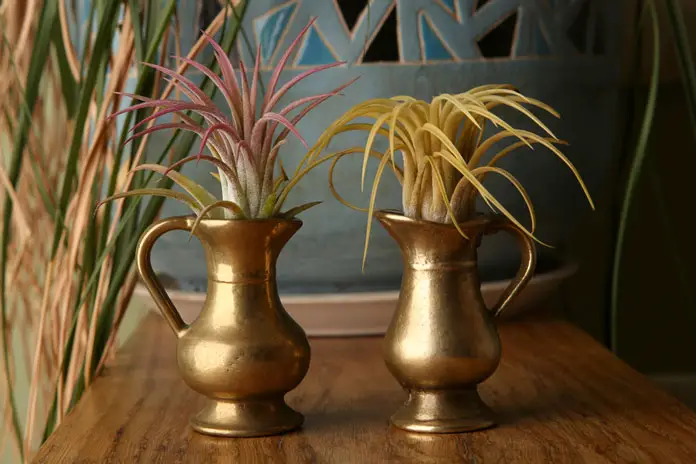
When to Water Air Plants
Generally speaking, an air plant will only need to be watered once a week in warm weather. They need less water in cooler periods, and none at all over the winter.
Signs you need to water include:
- Loss of color
- Curling leaves
- Brown leaf tips
- Wrinkled base of plant
Best Water for Air Plants
Before we begin, it’s important to establish the best water to give your air plant. Most folks start watering their indoor plants with tap water. It’s an easy choice, but one that has its own drawbacks. Chief of these is that tap water isn’t pure.
Safe, healthy tap water is usually heavily treated with chlorine to prevent disease, and many areas adds fluoride to improve dental health. Plants have different needs, so that life-saving chlorine can build up in plant tissues and cause problems.
Most town water is also what we’d call ‘hard’ water. It’s full of mineral salts, naturally occurring compounds that can build up in the soils or on the leaves of plants. Air plants in particular are at risk of developing a fine film of salt crystals over their leaves, clogging the surface and preventing them absorbing the water at all.
For all indoor plants, rainwater is best. Another option is distilled water. It can be purchased quite cheaply by the bottle, or can be collected from dehumidifiers and some HVAC systems.
Personally, I like filtered water. By running water through a filter, you remove the harmful components and provide as much clean water as you need. Under counter filtration is the most efficient way to do this, but I get quite a lot of use out of a cartridge style filter jug like the Soma Water Filter.
No matter what water you use, always ensure the water at room temperature. No one likes a cold shower, after all!
Watering Air Plants with a Mister
The lowest effort way to water an air plant is to spritz it with clean water using a plant mister.
To water with a mister:
- Start by fill your plant mister with clean water and moving the plant to a waterproof area.
- Really drench the Tillandsia with a fine mist. Keep spraying until the plant is dripping.
- Tip any water out that has collected inside the plant’s rosettes
- Allow to dry before returning it to its spot.
Watering Air Plants with Running Water
Another option is to rinse them under running water, like a faucet. This allows you to clear the Tillandsia of debris, like cobwebs or excess dust in addition to watering them.
To water an air plant under running water:
- Remove the air plant from its display
- If using a faucet, set the flow to a lukewarm temperature. Jugs can be left on a counter until they reach room temperature.
- Place the air plant under the flow of water, rotating to allow each leaf to be rinsed. Continue until the whole plant is wet.
- Rest the air plant upside down on a towel or rack and allow to drain.
- Once the plant is completely dry replace it in its spot.
Watering Air Plants by Dunking
Far and away the most comprehensive way to water an air plant is to soak it in a tub or basin of water. It might seem dramatic, but all it does is keep the water close to the trichomes until the plant has taken in its fill.
This is my preferred method of watering Tillandsias. It allows easy control of your water quality and ensures that even the most parched of plants gets everything it needs to thrive.
To water by dunking, you will need:
- A large basin, tub or container big enough to contain your air plant.
- Abundant clean water
- Towel or rack for drying
- A plate or dish (optional)
To water by dunking:
- Fill the basin or tub with enough water to completely submerge your air plant.
- Take your air plant and place it in the water, rotating until there are no more bubbles.
- Allow your plant to sit underwater for 15 to 30 minutes. For badly neglected plants, allow to soak overnight. Large plants may need to be held underwater by gently resting a dish or plate on top.
- Remove your air plant and place upside down to on a towel or rack to drain.
- Once thoroughly dry, you can return your air plant to its usual position.
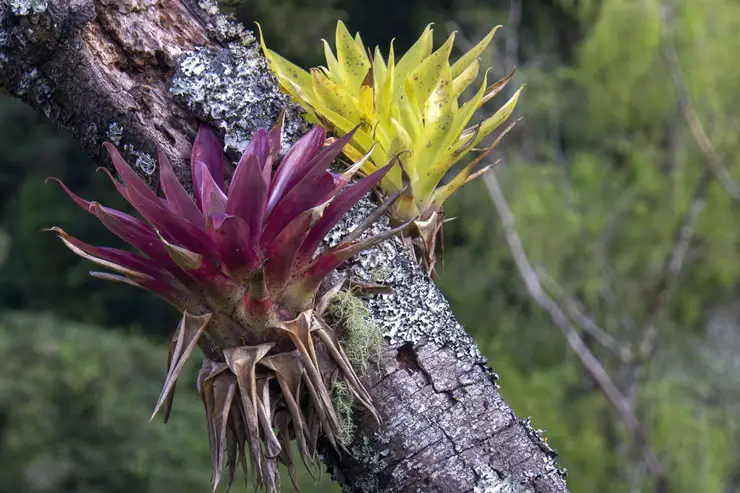
Best Temperature and Humidity for Air Plants
Air plants do best when grown in areas between 65 and 85℉ (18 to 30°C), and no colder than 50℉ (10°C) overnight.
They also need a reasonably consistent amount of humidity, of around 40 to 50%. They’ll tolerate lower levels of atmospheric moisture, though don’t be surprised if they dry out more frequently.
No matter where they wind up, make sure they’re getting good ventilation. Air plants need to dry out the surface of their leaves between watering, or they risk mold or mildew setting up camp under that delicate silver fuzz.
How to Propagate Air Plants
Air plants are very easy to propagate, though you’ll have to be patient. Tillandsias produce small offshoot plants known as pups that appear at the base of the parent plant just after flowering. Only adult plants produce flowers, however, and it takes them four or five years to reach maturity.
Once you do see a bloom, it signals a few things. First is that your air plant will soon wither and die. It’s sad, but it’s a natural part of the plant’s life cycle. In the wild, air plants cluster in tight groups, each generation dying back to allow the new to spring forth.
For an indoor gardener, this means that as the Tillandsia dies, it produces two or more whole new baby plants that can be separated from the dying parent. They’ll appear at the base of the air plant, down where any other plant would have its roots. Once the pups are about a third the size of the parent you can separate them gently with clean shears or scissors. They can then be treated as tiny new air plants, and more or less watered and cared for in the same way. I go into more about that and how to propagate air plants in general here.
How to Fertilize Air Plants
Air plants are more than capable of making their own fertilizer. They take dust from the air and water and turn into nutrients all by themselves.
But if you’re keen on growing the biggest air plant you can, it’s a good idea to give them a bit of a boost every now and then. Tillandsias are a bit chemically sensitive, so your best approach is to add a small dose of dilute bromeliad fertilizer to their soaking water. Fertilize once a month during the warmer parts of the year, between late spring and early autumn. They don’t need any at all over winter, too.
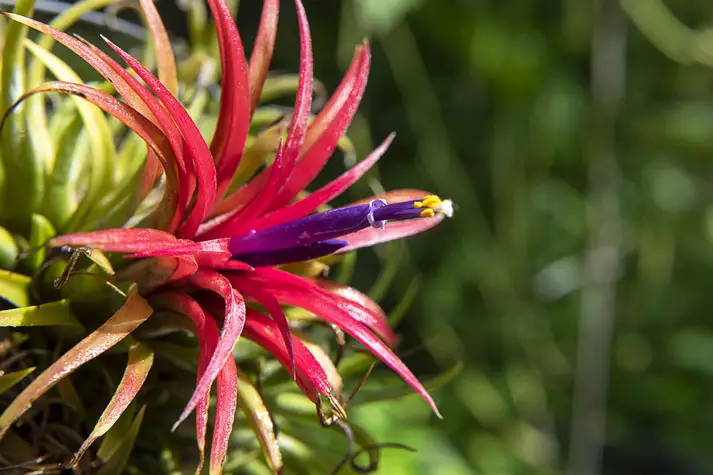
Air Plant Problems
Why is my air plant changing color?
Air plants change color as they mature or as a response to light levels. Xeric air plants in particular can become spectacularly colored, ranging from their standard silvery gray through to bright pinks and even purples and teal.
Colors to watch out for are brown and yellow, which signal dehydration. Pale bleached patches can also be caused by exposure to direct sunlight, so it’s worth inspecting their growing environment to see whether an errant sunbeam has snuck in.
Brown and black are bigger issues, especially if they’re accompanied by soft tissue or unpleasant smells. Water that’s left to accumulate in the crooks of their leaves can become septic in time, rotting away the leaf beneath. You may need to carefully trim away any sick tissue and allow the remaining plant to dry out.
Why is my air plant dying?
First, air plants can sometimes seem a bit unresponsive if they’ve been neglected for a while. Curled leaves, dull color and stalled growth all suggest an untimely demise, but it could just be that the poor thing’s feeling a bit dehydrated. Give the air plant a good soaking overnight and you might be surprised to see it rise from the grave. You can see the difference between a thriving air plant and a dying one here.
Other things to check are light level and temperature. Tillandsias need bright but indirect light. They don’t do well in the shadows for extended periods of time. A sad air plant might just need to move to a better lit area. Likewise, these tropical treats need a consistently warm environment, so avoid letting them get too cold. Check too that the ventilation is good and the air plant isn’t sitting in stale air all day.
Finally, if you’ve seen a flower on your air plant, death is assured as part of the natural life cycle of the plant. A perfectly cared for plant will die after blooming just as inevitably as one that’s been struggling. There’s nothing you can do about it except keep an eye out for pups.
Why won’t my air plant grow?
Air plants are slow growers, so it’s easy to miss their tiny achievements. If you’re worried, check that you’re hitting the marks in regards to light and water. Tillandsias have specific needs that must be met in order for them to be at their best, and without that they’ll just plod along.
Check that they are getting at least six hours of bright indirect light a day, and that they are kept well hydrated. I’d also suggest you check humidity and temperature levels in their growing environment and make sure it’s well ventilated. Finally, you can always give them a bit of diluted fertilizer during the warm end of the year.
Why does my air plant smell bad?
Bad smells are always bad news when it comes to your air plants.
If your air plant is smelling foul, take a good look at the base of its leaves. Odds are good you’ll find areas of soft, black rot. This is a consequence of letting water rest in those nooks and crannies after they’ve been watered. They may also develop rot if the ventilation around them is poor.
Drastic action is needed. Trim away any infected leaves and rinse free any soft, rotten tissue. Allow the air plant to dry, then apply powdered cinnamon to the exposed wounds. Cinnamon is a surprisingly effective anti-fungal agent, ideal to use on a chemically sensitive plant like Tillandsias.
With luck and patient care, your Tillandsia may yet spring back. They are, after all, tremendously resilient plants.
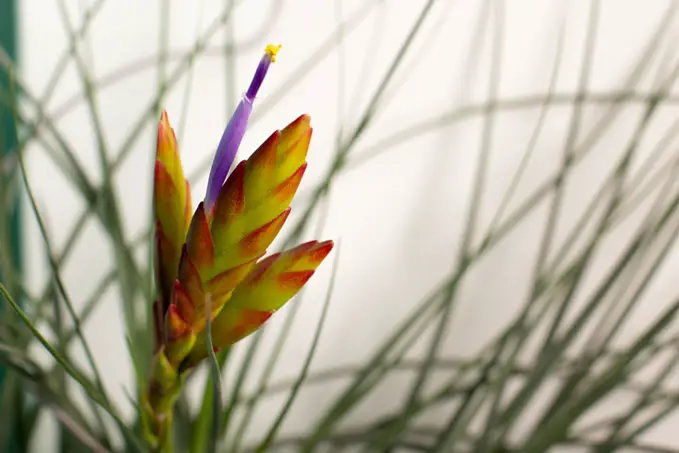
FAQ
How Long Do Air Plants Live?
Depending on the variety you’re growing, Air Plants can live for five to seven years. It does come down to how well they are tended, however. A plant that is perfectly cared for will bloom once it matures and dies. Ironically a Tillandsia that’s had less than ideal care may never muster the energy to flower and live on for a year or two longer than it would otherwise have managed.
But even if you do have a dying air plant, check for pups. It’s possible to always have an air plant in the same part of your home or office – a long line of parent and child.
Do Air Plants Grow Flowers?
A flower is a big deal in a Air Plants life, as they only bloom once before dying. All varieties are capable of growing blooms, though some are more dramatic than others. Only a mature plant will flower, at around four or five years of age.
Flower buds take a few months to develop, and produce a colorful bloom on a long stem. Sometimes the uppermost leaves of the air plant will change to bright reds, oranges or golds in order to better show off the flower.
How Big Do Air Plants Grow?
Air plants vary a lot depending on the variety you have. Most indoor cultivars will only reach around 6 to 7 inches tall. Others are smaller, like the T. ionatha variety ‘Peach’. Others, like the T. xerographica, can sprawl to over three feet across given the right conditions.
Are Air Plants Safe for Cats and Dogs?
Like most bromeliads, Air Plants are generally considered safe for cats and dogs. There’s no specific chemical in the plant that will poison them.
This doesn’t mean that nibbling them won’t cause your pet problems, however. The tough leaves can cause irritation, and some pets develop vomiting or diarrhea after scarfing down on an air plant. In general, it’ll resolve itself, but there’s nothing lost in phoning your vet for advice.
Where Do I put my Air Plant?
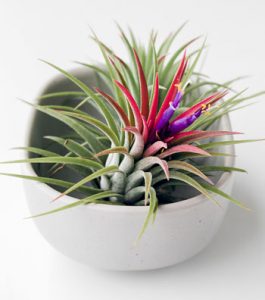
Air plants need good light, warm temperatures, moderate humidity and good ventilation. It sounds like a long and torturous list, but it describes a lot of areas in your home or office. Bathrooms and kitchens generally have good light and good ventilation, as well as regular doses of humidity from warm showers and the steam generated during cooking.
But any well-lit area can host an air plant. I’ve got a small cluster on my desk facing a southern window. They don’t seem to mind helping me at my work at all, and I’m certainly happier to have their company, too.
